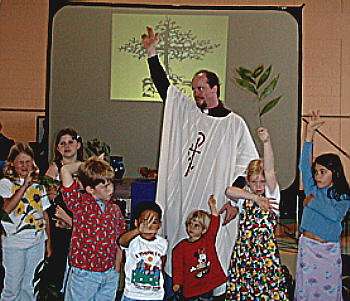![]()
General Board of Global
Ministries
![]()
UM Information
![]()
UM Reporter
![]()
![]()
Favorite Places
![]()
![]() Florida Southern College
Florida Southern College
![]()
![]() Bethune Cookman College
Bethune Cookman College
![]()
![]() FL
UM Children's Home
FL
UM Children's Home
|
|
Churches struggle with contemporary worship |
|
The Rev. Roy Terry says dress is an important element of contemporary worship because people need to know they won't be judged based on the style of clothing they wear to church. He said what he wears to worship, a liturgical collar and blue jeans, reflects the style of worship. "It's almost a post-modern blending of traditional and casual." he said. |
By Michael Wacht LAKELAND — The top reason churches start a contemporary worship service is to reach a different age group, according to a 1998 survey done by the conference’s New Church Development and Church Redevelopment office. The second reason is to reach the unchurched. While new, contemporary services seem to be meeting the goals churches have set for them, many church members and pastors struggle with what contemporary worship is and whether it is right for their church. "It [contemporary worship] means something different to everybody," said Dan Francabandiero, president of the Fellowship of United Methodists in Music and Worship Arts and organist at Riverside Park United Methodist Church in Jacksonville. "Every church has to define what contemporary means to them." The Rev. Roy Terry, pastor of three-year-old Cornerstone United Methodist Church in Naples, says his church’s leadership is intentional about not labeling their worship. They allow it to be shaped by the people leading and participating in it. "We have not allowed ourselves to be limited by title…" he said. "That’s the beauty of the diversity at Cornerstone. We have more freedom than those who designate themselves contemporary or traditional, because, to us, it just doesn’t matter." The defining characteristic of today’s contemporary worship is "music influenced by the rock genre," Francabandiero said, adding other elements include a lack of liturgy, a praise band and informality. Terry says the defining characteristic is participation and that liturgy can still be a vital part of worship. "Lively worship has more to do with the participation of the people," he said. "That’s what liturgy means. The statement about unchurched people not responding to liturgical elements I find to be false. It’s a matter of educating them about what they mean." Although the definition of contemporary worship remains the subject of debate, one result of starting a new service is increased attendance. As United Methodists across the country attempt to reverse three decades of membership decline, more churches are starting new services to garner new members. According to the 1998 New Church Development study, 166 churches — more than half of those responding — said they had started a new service; 43 percent said they intended to start one in the future. Churches that started new services reported a combined attendance increase of 14,413 people, an average of almost 90 new people per church. Starting a contemporary worship service has the potential to either divide or enhance a church, says Francabandiero, who urges churches to offer a variety of services to meet people’s needs. Terry says his church’s weekly worship service is a blend of "historic and apostolic," contemporary and high-tech elements. Music is provided by both a praise band and choir, the cross is processed and recessed, the congregation recites creeds and responds to questions Terry asks during his sermons. Communion is celebrated each week, followed by healing circles in which church members lay hands on each other and pray for healing. Even the church’s video projection combines technology and tradition, Terry said. During the service, a picture of a stained-glass window is projected on the screen, giving the cafeteria where the service takes place the feeling of a sacred space. Hymn and chorus lyrics are also projected, so worshippers’ hands are free for other activities, like clapping. Francabandiero says churches considering starting contemporary services should take their time and do extensive research before making any changes. He said churches should also add to their existing worship schedule. "Don’t replace what’s already in place," he said. "Add to what’s in place." Churches also should not expect their current musicians to automatically adapt to contemporary worship. He says church leaders should look for people who are excited and knowledgeable about different aspects of worship, including music, drama and technology. "Make sure you’re asking someone to do something that’s one of their gifts," he said. Although the idea of contemporary worship seems to have surfaced in the past few decades, Francabandiero said the debate over worship style in Methodism dates back to its earliest days. "When John Wesley was using bar songs for his brother’s hymns, people were
having the same conversations," he said. "People then were asking,
‘What’s church music coming With almost 30 years experience in church music, Francabandiero says contemporary worship is more than just a fad. "It’s part of the evolution of worship," he said. "In the end, the best of it will survive." Top
of this page |

